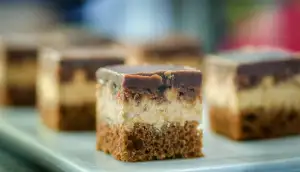Unleash Your Culinary Creativity: Discover the Best Cream of Tartar Substitutes for Your Recipes

- Explanation of why a substitute for cream of tartar may be needed
- Alternative options to use instead of cream of tartar
- Baking powder as a leavening agent
- Lemon juice or vinegar for acidity
- Yogurt or buttermilk for moisture and tanginess
- Whipped egg whites for stabilizing and adding volume
- Tips and guidelines for using substitutes effectively
Cream of tartar, also known as potassium bitartrate, is a versatile ingredient commonly used in cooking and baking. It is a byproduct of winemaking and has a powdery texture with a slightly acidic taste. Cream of tartar is often used as a stabilizer, leavening agent, and to add volume to recipes. It is commonly found in meringues, soufflés, angel food cakes, and other baked goods. Its acidic properties also help prevent sugar crystallization in syrups and candies. Cream of tartar plays an essential role in many recipes, but there are times when you may need to find suitable substitutes for it.
Explanation of why a substitute for cream of tartar may be needed
There are several reasons why you may need a substitute for cream of tartar in your recipes. Firstly, cream of tartar is not always readily available in every kitchen pantry. It is a specialty ingredient that may not be stocked in regular grocery stores. Secondly, some people may have dietary restrictions or allergies that prevent them from using cream of tartar. Lastly, if you simply run out of cream of tartar and don't have time to go to the store, having alternative options on hand can save the day.
Alternative options to use instead of cream of tartar
Alternative options to use instead of cream of tartar include baking powder, lemon juice or vinegar, yogurt or buttermilk, and whipped egg whites. Baking powder can be used as a leavening agent in recipes that require cream of tartar for its acidic properties. Lemon juice or vinegar can provide the necessary acidity and can be used in small amounts to replace cream of tartar. Yogurt or buttermilk can be used to add moisture and tanginess to recipes instead of cream of tartar. Lastly, whipped egg whites can be used as a substitute for cream of tartar when it is needed for stabilizing and adding volume to recipes. These alternatives offer flexibility and allow you to experiment with different flavors and textures in your culinary creations.
Baking powder as a leavening agent
Baking powder can be a great substitute for cream of tartar when it comes to providing leavening in your recipes. It is a combination of baking soda, cream of tartar, and sometimes cornstarch. The cream of tartar in baking powder acts as an acid, which activates the baking soda and helps dough or batter rise.
To replace cream of tartar with baking powder, simply use three times the amount of baking powder as the recipe calls for cream of tartar. For example, if the recipe requires 1 teaspoon of cream of tartar, you would use 3 teaspoons (or 1 tablespoon) of baking powder instead.
Keep in mind that using baking powder as a substitute may slightly alter the taste and texture of your final dish. Baking powder contains additional ingredients like cornstarch, which can affect the flavor and consistency. However, in most recipes, this difference is minimal and won't significantly impact the end result.
It's important to note that if your recipe already includes baking powder along with cream of tartar, you don't need to make any adjustments. The combination of both ingredients will provide optimal leavening.
Experimenting with different substitutes can be an exciting way to unleash your culinary creativity while still achieving delicious results. So don't hesitate to try out using baking powder as a leavening agent when you find yourself without cream of tartar in your pantry!
Lemon juice or vinegar for acidity
Lemon juice or vinegar can be excellent substitutes for cream of tartar when it comes to adding acidity to your recipes. Both lemon juice and vinegar have a tangy flavor that can enhance the taste of your dishes. They work particularly well in recipes that require cream of tartar for activating baking soda as a leavening agent.
To substitute cream of tartar with lemon juice or vinegar, simply use an equal amount of either ingredient. For example, if a recipe calls for 1 teaspoon of cream of tartar, you can replace it with 1 teaspoon of lemon juice or vinegar.
It's important to note that the substitution may slightly alter the taste and texture of your final dish. Lemon juice and vinegar have distinct flavors that can add a subtle tanginess to your recipes. Therefore, it's best to choose the option that complements the other ingredients in your dish.
When using lemon juice as a substitute, make sure to strain out any seeds or pulp before adding it to your recipe. Similarly, when using vinegar, opt for mild varieties like white vinegar or apple cider vinegar to avoid overpowering flavors.
Keep in mind that lemon juice and vinegar may not provide the same leavening power as cream of tartar. If you're using them as substitutes in baked goods, consider adding a small amount of baking powder along with the lemon juice or vinegar to ensure proper rising.
Overall, lemon juice and vinegar are versatile alternatives to cream of tartar that can add acidity and enhance flavors in your cooking. Experiment with different recipes and find which option works best for you!
Yogurt or buttermilk for moisture and tanginess
Yogurt and buttermilk are excellent substitutes for cream of tartar when it comes to adding moisture and tanginess to your recipes. These dairy products not only provide the desired texture but also enhance the flavor profile of your dishes.
Yogurt, with its creamy consistency, works well in both sweet and savory recipes. It adds moisture to baked goods like cakes, cookies, and breads, resulting in a tender crumb. Additionally, yogurt's tangy taste can help balance out the sweetness in desserts.
Buttermilk, on the other hand, is commonly used in baking to create moist and fluffy textures. Its acidic nature activates baking soda, acting as a leavening agent. This makes it an ideal substitute for cream of tartar when making pancakes, waffles, or biscuits.
To use yogurt or buttermilk as a substitute for cream of tartar, simply replace each teaspoon of cream of tartar with 1 ½ teaspoons of either yogurt or buttermilk. Adjust the amount according to your recipe's requirements.
Remember that these substitutes may slightly alter the taste and texture of your final dish. So be sure to experiment and adjust accordingly until you achieve the desired results. With yogurt or buttermilk as alternatives to cream of tartar, you can unleash your culinary creativity while enjoying moist and flavorful creations.
Whipped egg whites for stabilizing and adding volume
Whipped egg whites are a fantastic substitute for cream of tartar when it comes to stabilizing and adding volume to your recipes. When whipped, egg whites create a light and airy texture that can be used in various dishes such as meringues, soufflés, and angel food cakes.
To use this substitute, start by separating the egg whites from the yolks. Make sure there are no traces of yolk in the whites as this can prevent them from whipping properly. Place the egg whites in a clean bowl and using an electric mixer or whisk, beat them until they form stiff peaks.
The whipped egg whites can then be folded into your batter or mixture gently. This will help to incorporate air into the mixture and provide structure. The result is a lighter and fluffier end product.
It's important to note that while whipped egg whites can be an excellent substitute for cream of tartar, they may not work well in every recipe. It's best suited for recipes where stability and volume are key factors.
Experiment with this substitute in recipes like chiffon cakes or pavlovas to see how it performs. Keep in mind that the texture may vary slightly compared to using cream of tartar, but it will still yield delicious results.
Remember to adjust other ingredients accordingly when using whipped egg whites as a substitute. For example, you may need to reduce the amount of liquid or increase the amount of flour in your recipe to compensate for the added moisture from the eggs.
In conclusion, whipped egg whites are a versatile option for replacing cream of tartar in recipes where stability and volume are needed. They provide a light and airy texture that can elevate your culinary creations. So go ahead and unleash your culinary creativity with this fantastic substitute!
Tips and guidelines for using substitutes effectively
When using substitutes for cream of tartar, it's important to keep a few tips and guidelines in mind to ensure successful results. Firstly, when using baking powder as a substitute, remember that it already contains cream of tartar, so adjust the measurements accordingly. Secondly, when using lemon juice or vinegar as a substitute for acidity, use them sparingly to avoid overpowering the flavor of your dish. Thirdly, when substituting with yogurt or buttermilk for moisture and tanginess, be mindful of their consistency and adjust other liquid ingredients accordingly. Lastly, when using whipped egg whites as a stabilizer and volume enhancer, make sure they are properly whipped to stiff peaks before incorporating them into your recipe. By following these tips and guidelines, you can effectively utilize substitutes for cream of tartar in your culinary creations.
In conclusion, the versatility of substitutes for cream of tartar allows you to unleash your culinary creativity in the kitchen. Whether you're baking a cake, making meringue, or whipping up some fluffy pancakes, there are alternative options that can effectively replace cream of tartar. Baking powder, lemon juice or vinegar, yogurt or buttermilk, and whipped egg whites all offer unique properties that can mimic the effects of cream of tartar in your recipes. So don't let the absence of cream of tartar hold you back from creating delicious dishes - experiment with these substitutes and discover new flavors and textures in your cooking adventures.
Published: 21. 11. 2023
Category: Food



